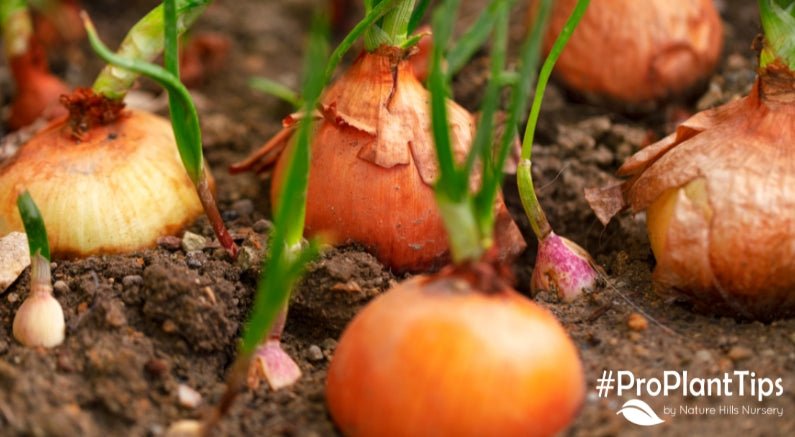Edible Onions are a culinary standard in recipes worldwide! Unlike the non-edible Ornamental Onions (Flowering Onions) that look pretty in the spring or summer months, edible Onions range from mild to very strong in terms of both flavor and odor.
Members of the Amaryllis family, along with Leeks, Garlic, Scallions, Ramps, and Shallots, There are 5 types of Onions for you to choose from and 3 related varieties - all of which are incredibly easy to grow and rewarding!
All About Onions
According to the National Onion Association, Onions began being used in a culinary sense in central Asia 5,000 years ago as food, art, medicine, and mummification, but Wild Onions were used long before that as a dietary vegetable in prehistoric times.
Onions contain antioxidants and compounds that can lower heart disease risk and protect against blood clots. High in dietary fiber, Vitamin C, Vitamin B6, Potassium, Folate, Calcium, and Iron. Onions add that special 'oomph' to fresh and cooked dishes, bringing a different flavor profile depending on whether they are used raw, roasted, grilled, pickled, caramelized, baked, fried, or sautéed.
The Main Types of Onions Include:
- Yellow Onions - Yellow papery skins, crisp, juicy, and mild/sweet finish
- Red/Purple Onions - Red/Purple papery skins - mild and pungent
- Sweet Onions - Yellow paper skins, Lower sulfur, sweeter taste, and often used fresh
- White Onions - White papery skins, zesty, pungent and full-flavored. Slow to bolt
- Spring Onions - Immature Onions - used like Green Onions/Scallions
- Shallots - A milder cross between Garlic and Onions
- Leeks - Mild flavor and stands up to cooking and stews
- Green Onions/Scallions

About Shallots
Shallots seem to be a cross between Onions and Garlic, forming layers like Onions but creating clove-like sections like Garlic. Even the flavor seems to be a combination of both, only milder than Garlic and a bit sweeter than Onions.
About Leeks

Leeks have fresh Onion flavor and are eaten as both the stronger white bases and milder green tops. They do not form bulbs at the base of the plant and form fast bunching groupings when left in the ground.
Mellowing the flavor and odor of raw Onions can be achieved by slicing very thinly or you can soak onion slices in cold water for as long as overnight to tone down their potency.
Difference Between Green Onions, Spring Onions, and Scallions
Green Onions and Scallions are the same thing and do not form bulbs. The green tops and the white base are both eaten fresh or cooked. Spring Onions are like small Green Onions with small bulbs beginning to form, and are typically harvested when young and the bulb hasn’t fully formed. Spring Onions are more flavorful than Green Onions/Scallions.

Chives
Another Allium family plant, naturalized and native and a garden standard, Chives are not pulled from the ground to harvest, instead, the clumping plants are trimmed with scissors to harvest and used as a mild oniony garnish and fresh seasoning, or dried for later use.
Wild Onions & Ramps
The native wild forms of Onions include Ramps, Wild/Meadow Onions, Garlic Chives, Wild Leeks, and Ramson (Cowleeks/Bear Leeks), which are all native or naturalized forms of Onion family plants.
Growing Onions
Onions are sold as seeds, transplants (young bulbs with some greens already started and sold in bundles), or as Onion sets (dormant bulblets). The latter is what Nature Hills will ship to your doorstep.
Grow yours in evenly spaced rows, raised beds, or sunny pots and planters.
Warmer (typically zones 7 and warmer) can plant Onion sets in the fall for a late spring harvest or in the early spring in cooler climates for a late summer harvest. Nature Hills ships your quality dormant bulbs to your growing zone at the proper planting time.

Onions readily grow in a range of climates and soil types. Here are the ideal growing conditions for these Vegetable Garden standards.
- Plant in full sun for the fastest growth and strongest stems
- Choose a loose, rich, well-drained soil location
- Plant each bulb a few inches apart
- Provide moderate to low moisture as needed throughout the growing season.
- Spread a layer of compost/mulch 3-4 inches deep for an extra layer of protection and fertility.
If you have clay soil, or soil that doesn’t drain well, grow your Onions in raised beds or containers.
Water them well after planting, then continue until established and during drought. Onion roots are shallow and need a steady supply of water to grow without interruption.
Harvesting & Storing Onions

Onions are ready for harvest as soon as their foliage withers. Locate the Onions beneath the dried foliage, then gently pry them out with a spade or spading fork. Pull the plants from the ground and allow them to sit on top of the soil for a couple of days to dry the roots.
After the first couple of days, move them into a barn, shed, garage, or covered porch and set them on a screen or mesh to cure for about 2 weeks for the Onions that you will store. Then you can braid them or keep them in mesh bags and store them in the basement where it is cool and dry. Tie the tops together to store them. Just ensure they have plenty of ventilation.
Create decorative Onion braids in your kitchen and give your surplus as gifts!
Growing Onions Without The Tears!
Easy to grow flavor for all of your kitchen creations, growing your own Onions is a rewarding space-saving experience!
Check out all the Onion varieties at NatureHills.com and order soon! Dormant bulbs are gearing up to start shipping based on your growing zone soon!
Happy Planting!


